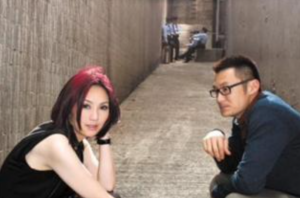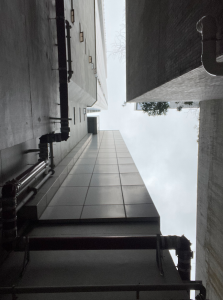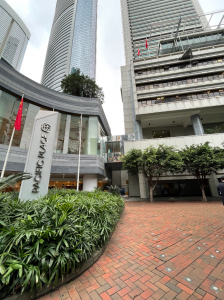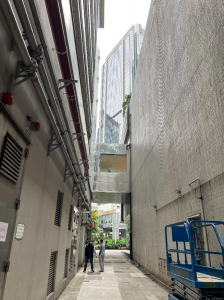LOVE IN A PUFF, DIR. PANG HO CHEUNG (2010)
Alleyway between Pacific Place and the Queensway Government Offices, Admiralty, Hong Kong

Cherie (Yeung) and Jimmy (Yue) smoked in the alleyway between Pacific Place and the Queensway Government Offices, in which the policeman also take a break. Scenes from the Media Asia Film’s Love in A Puff 2010, directed by Pang Ho Cheung.
Media Asia Film Co., Ltd. released Love in A Puff in March 2010. The film tells the story of how the tightening regulations on smoking drive hardcore smokers to the open areas, leading to unlikely connection. The two alleyways located between grand and modern buildings of Hong Kong are the recurring background of the two protagonists’ love story.
The story begins when the protagonists meet during a break from work for smoking, in the alleyway behind the Empire Hotel Kowloon in Tsim Sha Tsui. Smoking becomes the key that facilitates the development of their relationship. But compared to the alleyway in which they first met each other, the alleyway that Cherie brought Jimmy to in avoidance of his ex-girlfriend is where they have more moments alone to nurture their relationship.It is located in Admiralty right between the walls of Pacific Place and Queensway Government Offices. There they hide away from the bustling and hustling of the modern metropolis.
The alleyway remains very much the same 11 years after the movie was produced, thanks to the commercial and public importance of the two buildings that enable its existence. There are even more cigarette butts on the floor than shown in the movie, proving that it is still frequented by cigarette smokers who work nearby. However, the atmosphere of the actual site is rather different from that of the movie. In the movie, there are always soft sun rays shining on the protagonists and light-hearted music playing to create a romantic mood. In fact, the two tall buildings blocked much of the sunlight shining into the alleyway and the built-in ventilation system gave out constant white noise so the alleyway is rather dark and dull in reality. Also, the film portrays the alleyway as a space in which workers from different industries socialize. In the movie, the cop flirts with Cherie, smokers talk to one another, despite their differences in ethnicity and professions. However, in reality, people only talk to their co-workers, while some even intentionally avoid others. Nonchalance has a greater presence there than friendliness.
But it is only by portraying the space as where connections form naturally that the occurrence of the romantic encounter of the protagonists seems convincing. The film also acts as a resistance against the “disappearance” of the HK identity.1 The director goes beyond the surface of the modern high rises that reinforces the stereotype of HK being the international financial centre and into the alleyway hidden from sight between those buildings. Inside this corner that is unnoticeable to tourists and some locals, the authentic side of HKers can be found. Instead of being professional as commonly represented in formal media, the workers slack off during work, use lots of Cantonese foul languages, poke fun at one another bluntly with jokes that reference lots of local culture and slangs that only locals can understand. The alleyway being visually anonymous means that this is just an ordinary love story that could happen to any HK lovers.
— Ngai Hiu Lam 3035693387

Looking up from the alleyway to the sky, the space seen is really narrow so little sunlight can enter the alleyway. So the alleyway is much darker in reality than in the film.

Modern Infrastructure of mobility: The alleyway is located between the Pacific Place (right) and the Queensway Government Offices. It is difficult for passersby or non-smokers to notice that the alleyway exists at all.

- The alleyway which Cherie brought Jimmy to for smoking and avoiding his ex-girlfriend.

In reality, smokers only talk to people they already know from work. People from different workplaces do not talk to one another.
Notes:
1 Ackbar Abbas, “Building on Disappearance: Hong Kong Architecture and the City,” Public Culture 6 (1994):445; 448.
Your effort to trace the site is appreciated. Your piece is highly structured and organized, from film introduction to comparative analysis and lastly an application of ideas from the class. The discussion on ‘disappearance’ was also on-point. The ‘reappearance’ of the visually anonymous resists against its ‘disappearance’ caused by the overly visible skyscrapers (as they are also often on media). Overall it is a good piece, it would be even better if your language is more concise, e.g. the first sentence of the last paragraph seems slightly clumsy in language. Do you mean it is the director’s decision to make encounters in the alleyway natural to possibly tell the story?